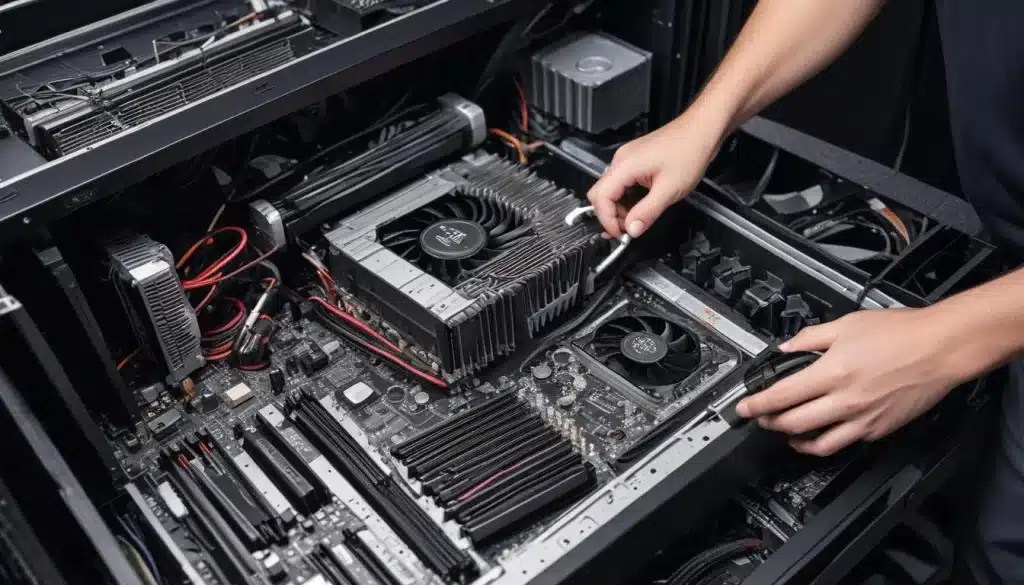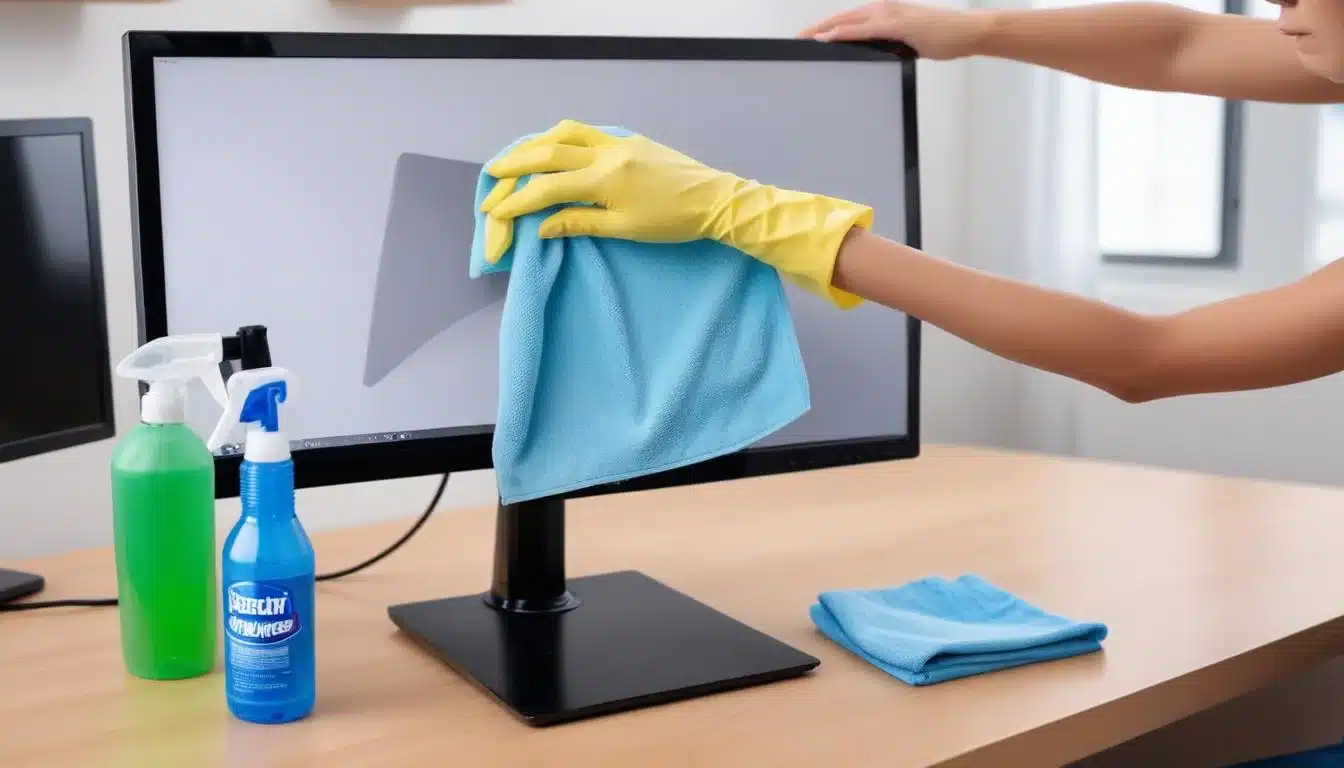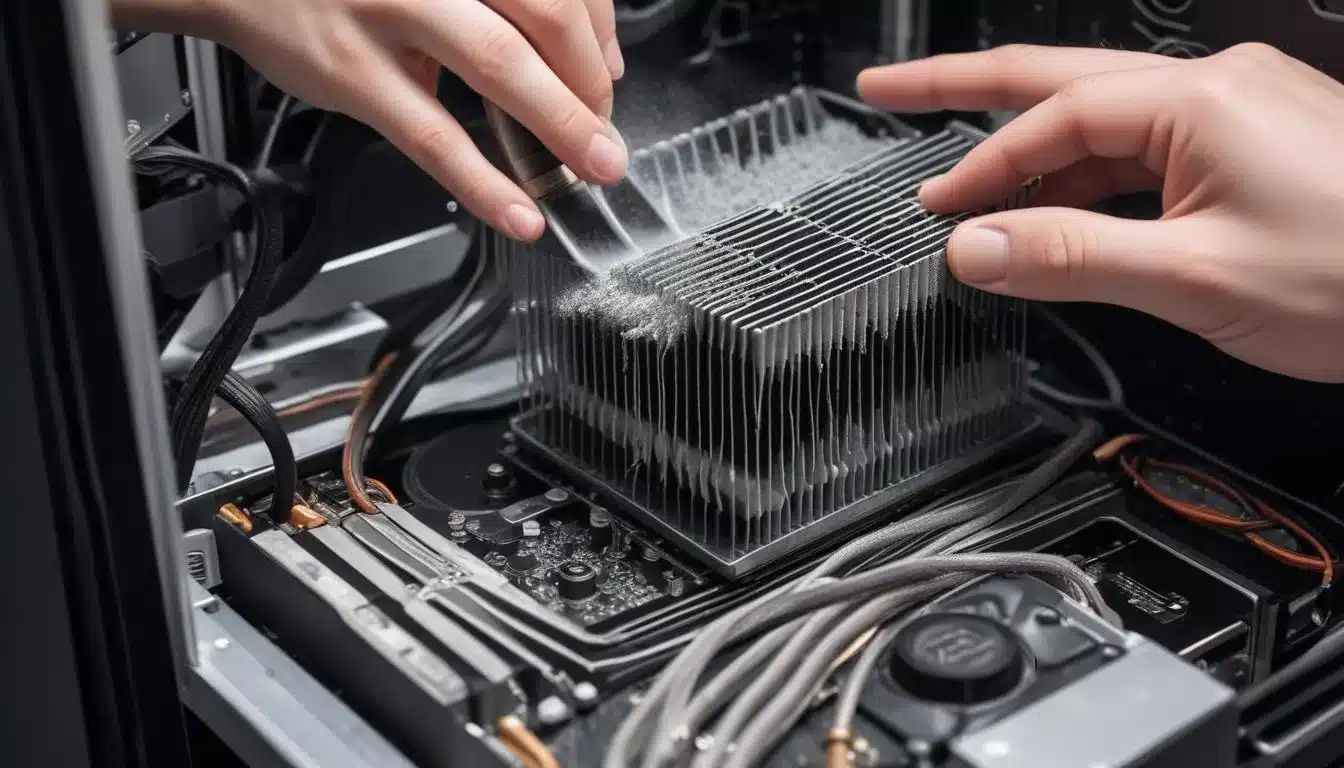Clean Your PC: Extend Lifespan & Boost Performance for 2+ Years

Knowing how to properly clean your PC is paramount for extending its operational lifespan and ensuring it maintains peak performance for two years or more, directly combating issues like overheating and reduced efficiency.
In today’s digital age, your PC is more than just a tool; it’s a gateway to work, entertainment, and connection. Yet, many users overlook a critical aspect of its well-being: regular cleaning. Learning how to properly clean your PC is not merely about aesthetics; it’s a fundamental practice that directly impacts its longevity and performance.
The Silent Killer: Why Dust and Debris Matter
Dust, pet hair, and other environmental debris are insidious enemies of your computer. They infiltrate every crevice, settling on crucial components and creating layers that act as thermal insulators. This section will delve into why these seemingly innocuous particles pose a significant threat to your PC’s health and how their accumulation can lead to a cascade of performance issues.
When dust accumulates on heatsinks and fans, it impedes the efficient dissipation of heat generated by your CPU and GPU. This leads to higher operating temperatures, which can severely degrade performance and accelerate component wear. Understanding this fundamental principle is the first step toward appreciating the importance of a clean machine.
Overheating: The Primary Consequence
Overheating is arguably the most detrimental effect of a dirty PC. When components get too hot, they automatically throttle their performance to prevent damage, leading to noticeable slowdowns and stuttering. In extreme cases, sustained high temperatures can cause permanent hardware failure, necessitating costly repairs or replacements.
- Reduced clock speeds and processing power.
- Frequent system crashes and freezes.
- Shorter component lifespan, especially for CPUs and GPUs.
- Loud fan noise as the system struggles to cool itself.
Beyond performance, dust can also interfere with electrical conductivity, potentially causing short circuits if moisture is present. While less common, this risk underscores the importance of a thoroughly clean environment inside your PC. Regular dust removal is not just about keeping temperatures down; it’s about protecting the intricate circuitry that makes your computer function.
In conclusion, the impact of dust and debris on your PC’s performance and lifespan cannot be overstated. It is a constant battle against environmental factors that seek to compromise your system’s efficiency. Proactive cleaning is your best defense against the silent killer, ensuring your computer operates at its best for years to come.
Essential Tools for a Thorough PC Cleaning
Before you embark on your PC cleaning journey, gathering the right tools is paramount. Using inappropriate materials can cause more harm than good, potentially damaging sensitive components or leaving behind residues. This section outlines the essential items you’ll need to perform a safe and effective cleaning of your computer.
Having the correct arsenal not only makes the job easier but also protects your investment. From specialized brushes to anti-static measures, each tool plays a crucial role in ensuring a meticulous and damage-free cleaning process.
Must-Have Cleaning Supplies
A well-prepared cleaning kit should include items designed specifically for electronics. Avoid household cleaners or abrasive cloths, as these can leave residues or scratch surfaces. Focus on tools that gently remove dust and grime without introducing new problems.
- Compressed Air Can: Essential for blowing dust out of tight spaces like heatsinks, fans, and vents. Ensure it’s held upright to prevent propellant discharge.
- Anti-Static Wrist Strap: Crucial for dissipating static electricity from your body, which can severely damage sensitive electronic components.
- Microfiber Cloths: Ideal for wiping down surfaces, screens, and cases without leaving lint or scratches.
- Isopropyl Alcohol (90% or higher): Used with cotton swabs or microfiber cloths for cleaning thermal paste residues or stubborn grime on non-sensitive components.
- Small Soft-Bristle Brush: Great for gently dislodging dust from fan blades and heatsink fins.
Additionally, a small set of screwdrivers might be necessary to open your PC case or remove specific components for deeper cleaning. Always ensure you have adequate lighting and a clean, spacious work area to prevent losing small screws or misplacing parts. Taking a photo before disassembly can also be a helpful reference.
By having these essential tools at your disposal, you can approach your PC cleaning with confidence, knowing you are equipped to handle the task safely and effectively. Proper tools are the foundation of a successful and damage-free maintenance routine.

Step-by-Step Internal PC Cleaning Guide
Cleaning the inside of your PC can seem daunting, but with a methodical approach, it’s a straightforward process that yields significant benefits. This guide will walk you through each step, ensuring you safely and effectively remove dust and debris from your computer’s critical internal components. Remember, patience and precision are key.
Before you begin, ensure your PC is completely powered down and unplugged from the wall. Disconnect all peripherals, including the monitor, keyboard, mouse, and any USB devices. Safety first is not just a motto; it’s a necessity when dealing with electronics.
Preparing for the Clean
Find a well-ventilated area, preferably outdoors or in a garage, to avoid re-depositing dust inside your home. Lay down a large, clean surface like an old sheet or newspaper to catch the dust. Put on your anti-static wrist strap and attach it to an unpainted metal part of your PC case to ground yourself.
- Power down and unplug all cables.
- Move to a well-ventilated, clean workspace.
- Ground yourself with an anti-static wrist strap.
- Open the PC case carefully, noting screw locations.
Cleaning the Components
Once the case is open, start with the largest and most accessible components, working your way to the smaller, more intricate areas. Use short bursts of compressed air, holding the can upright to prevent liquid propellant from spraying onto components. Hold fan blades gently to prevent them from spinning too fast, which can damage their bearings.
Focus on the CPU heatsink and fan, GPU heatsink and fans, case fans, and the power supply unit (PSU). For the PSU, blow air through its vents, but avoid disassembling it unless you are an expert, as it contains high-voltage capacitors that can be dangerous. Use your soft-bristle brush for stubborn dust on fan blades and heatsink fins, always brushing away from components.
For any sticky residue or grime, lightly dampen a microfiber cloth or cotton swab with isopropyl alcohol and gently wipe the affected area. Be extremely careful around sensitive circuit boards and connectors. Once all visible dust is removed, close your PC case, ensuring all screws are properly tightened. Reconnect peripherals and power up your system.
By following these steps, you can confidently clean the internal components of your PC, significantly reducing the risk of overheating and extending its operational lifespan. This methodical approach ensures no critical area is overlooked.
External Cleaning and Peripheral Maintenance
While internal cleaning is crucial for performance, maintaining the external cleanliness of your PC and its peripherals is equally important for hygiene, longevity, and overall user experience. This section will guide you through the best practices for keeping your computer’s exterior and connected devices spotless.
A clean external surface not only looks better but also prevents dust from re-entering the system and ensures optimal airflow through vents. Moreover, regularly cleaning your keyboard, mouse, and monitor can significantly reduce the spread of germs and enhance comfort.
Cleaning the PC Case and Vents
The exterior of your PC case can accumulate dust and grime, especially around air intake and exhaust vents. Use a microfiber cloth, slightly dampened with water or a mild electronic cleaner, to wipe down all external surfaces. Pay close attention to the vents, ensuring they are free from obstructions to allow for proper airflow. A soft brush can help dislodge dust from intricate vent grilles.
- Wipe down the entire case with a microfiber cloth.
- Clean air intake and exhaust vents thoroughly.
- Avoid spraying liquids directly onto the case; apply to the cloth first.
- Check for and clean any dust filters on the case.
For screens, use a dedicated screen cleaner and a clean microfiber cloth. Spray the cleaner onto the cloth, not directly onto the screen, and wipe gently in one direction to avoid streaks. For keyboards, compressed air can remove debris between keys, followed by a wipe-down with a disinfectant wipe or an isopropyl alcohol-dampened cloth. For mice, clean the optical sensor and the body with a similar approach.
Regular external cleaning complements internal maintenance, creating a holistic approach to PC care. It ensures that your entire workspace remains hygienic and that your computer can breathe freely, contributing to its sustained performance and extending its life far beyond typical expectations.

Software Maintenance: The Digital Clean-Up
Physical cleaning addresses the hardware, but a truly optimized PC requires attention to its digital counterpart: software. Over time, your operating system can become cluttered with temporary files, unnecessary programs, and fragmented data, all of which can significantly impact performance. This section explores essential software maintenance practices to keep your PC running smoothly.
Just as dust slows down hardware, digital clutter slows down software. Regular digital clean-up ensures that your system resources are efficiently utilized, preventing slowdowns and improving responsiveness. This holistic approach to maintenance is key to a long-lasting, high-performing PC.
Key Software Cleaning Practices
Several tools and techniques can help you declutter your digital environment. These practices are often overlooked but are just as vital as physical cleaning for maintaining peak performance.
- Disk Cleanup: Utilize your operating system’s built-in disk cleanup utility to remove temporary files, system logs, and old updates. This frees up valuable storage space.
- Uninstall Unused Programs: Regularly review your installed applications and uninstall any programs you no longer use. These can consume resources in the background and take up disk space.
- Defragment Hard Drives (HDD only): For traditional Hard Disk Drives (HDDs), defragmentation organizes scattered data, improving access speeds. Solid State Drives (SSDs) do not require defragmentation.
- Malware and Virus Scans: Run regular, full system scans with reputable antivirus and anti-malware software to detect and remove malicious threats that can degrade performance and compromise security.
- Update Drivers and OS: Keep your operating system and hardware drivers updated. Updates often include performance enhancements, bug fixes, and security patches.
Beyond these, consider managing your startup programs to reduce boot times and system load. Many applications configure themselves to launch automatically with Windows, consuming precious RAM and CPU cycles. Disabling unnecessary startup items can make a noticeable difference in your PC’s responsiveness.
By regularly performing these software maintenance tasks, you can ensure your PC’s digital environment is as clean and efficient as its physical components. This combined approach is the most effective way to extend your computer’s lifespan and maintain optimal performance for years to come.
Establishing a Regular PC Cleaning Schedule
Consistency is key when it comes to PC maintenance. A one-time clean will offer temporary relief, but establishing a regular cleaning schedule is what truly extends your PC’s lifespan and ensures sustained optimal performance. This section will help you develop a practical and effective routine tailored to your usage and environment.
Just like any other valuable asset, a PC benefits from routine care. Without a schedule, it’s easy to forget about cleaning until performance issues become undeniable. A structured approach removes the guesswork and ensures timely intervention.
Recommended Cleaning Frequency
The ideal cleaning frequency depends on several factors, including your environment, PC usage, and whether you have pets. However, general guidelines can help you establish a baseline.
- External Cleaning (Case, Peripherals, Screen): Weekly or bi-weekly. This prevents dust buildup on surfaces and maintains a hygienic workspace.
- Internal Dust Removal (Compressed Air): Every 3 to 6 months. This is crucial for preventing significant dust accumulation on heatsinks and fans.
- Deep Internal Cleaning (Component Removal): Annually, or every 12-18 months. This involves more thorough cleaning, potentially reapplying thermal paste, and is best done when you feel comfortable disassembling more components.
- Software Maintenance (Disk Cleanup, Scans): Monthly. Regular digital clean-ups keep your operating system lean and efficient.
Consider your specific circumstances. If you live in a dusty environment, have pets that shed, or use your PC extensively for gaming or demanding tasks, you might need to increase the frequency of internal dust removal. Conversely, a clean, air-filtered environment might allow for slightly less frequent internal cleaning.
Setting reminders on your calendar or using specialized software can help you adhere to your cleaning schedule. Think of it as a small investment of time that pays dividends in extended PC life and consistent, high-level performance. A well-maintained machine is a reliable machine.
Common Mistakes to Avoid During PC Cleaning
While the benefits of cleaning your PC are clear, making certain mistakes during the process can lead to damage or inefficient results. Being aware of these pitfalls is just as important as knowing the correct procedures. This section highlights common errors to avoid, ensuring your cleaning efforts are both safe and effective.
Even with the best intentions, improper cleaning techniques can introduce new problems, from static discharge damage to component corrosion. Understanding what not to do is crucial for a successful and risk-free maintenance session.
Pitfalls to Steer Clear Of
Before you even pick up a can of compressed air, consider these common mistakes that many users make, often unknowingly, when attempting to clean their computers.
- Using a Vacuum Cleaner: While powerful, vacuum cleaners generate significant static electricity, which can fry sensitive components. Their suction can also dislodge or damage small parts.
- Blowing Air with Your Mouth: Your breath contains moisture and can introduce saliva, leading to corrosion and short circuits. It’s also ineffective for dislodging stubborn dust.
- Spraying Liquids Directly: Never spray cleaning solutions directly onto components or screens. Always apply the liquid to a microfiber cloth first to control moisture.
- Disregarding Static Electricity: Static discharge is an invisible threat. Failing to use an anti-static wrist strap or work on a grounded surface can lead to irreversible component damage.
- Over-spinning Fans: When using compressed air, hold fan blades gently to prevent them from spinning too rapidly. This can damage their bearings and shorten their lifespan.
- Using Abrasive Materials: Harsh cloths, paper towels, or chemical cleaners can scratch surfaces, leave residues, or corrode plastics. Stick to microfiber cloths and isopropyl alcohol.
Another common mistake is neglecting to fully power down and unplug the PC. Working on a powered system or one still connected to an outlet poses electrical shock risks and can damage components. Always ensure the system is completely de-energized before opening the case.
By being mindful of these common mistakes, you can protect your PC from accidental damage during cleaning. A careful and informed approach ensures that your efforts contribute positively to your computer’s health and longevity, rather than inadvertently causing harm.
| Key Aspect | Brief Description |
|---|---|
| Dust Accumulation | Major cause of overheating and reduced PC performance, accelerating component wear. |
| Essential Tools | Compressed air, anti-static strap, microfiber cloths, isopropyl alcohol are crucial. |
| Cleaning Frequency | Internal cleaning every 3-6 months, external weekly, software monthly. |
| Mistakes to Avoid | Never use vacuum cleaners, blow with mouth, or spray liquids directly on components. |
Frequently Asked Questions About PC Cleaning
It’s generally recommended to clean the inside of your PC with compressed air every 3 to 6 months. If you live in a dusty environment or have pets, you might need to do it more frequently, perhaps every 2-3 months, to prevent excessive dust buildup.
No, you should never use a regular vacuum cleaner to clean the inside of your PC. Vacuum cleaners generate significant static electricity, which can easily damage sensitive electronic components. Always use compressed air and an anti-static wrist strap for internal cleaning.
An anti-static wrist strap is a safety device worn on your wrist and connected to a grounded object, like your PC case. It safely dissipates static electricity from your body, preventing accidental electrostatic discharge (ESD) that can permanently damage delicate computer components during cleaning or upgrades.
Yes, isopropyl alcohol (90% concentration or higher) is safe for cleaning non-sensitive PC components. It evaporates quickly and leaves no residue. Use it sparingly on a microfiber cloth or cotton swab to clean thermal paste residue or stubborn grime, avoiding direct application to circuit boards.
Software maintenance, like disk cleanup, uninstalling unused programs, and regular virus scans, prevents digital clutter and malware from slowing down your system. A lean, efficient operating system reduces the strain on hardware, ensuring components don’t work harder than necessary, thereby extending their lifespan and maintaining performance.
Conclusion
Mastering how to properly clean your PC is an indispensable skill for any computer owner. It’s a proactive measure that directly combats the silent threats of dust, heat, and digital clutter, ensuring your machine remains a reliable and high-performing asset for well over two years. By consistently applying the physical and digital cleaning techniques outlined, you not only safeguard your investment but also enhance your overall computing experience, allowing you to enjoy seamless performance and extended longevity from your essential device.